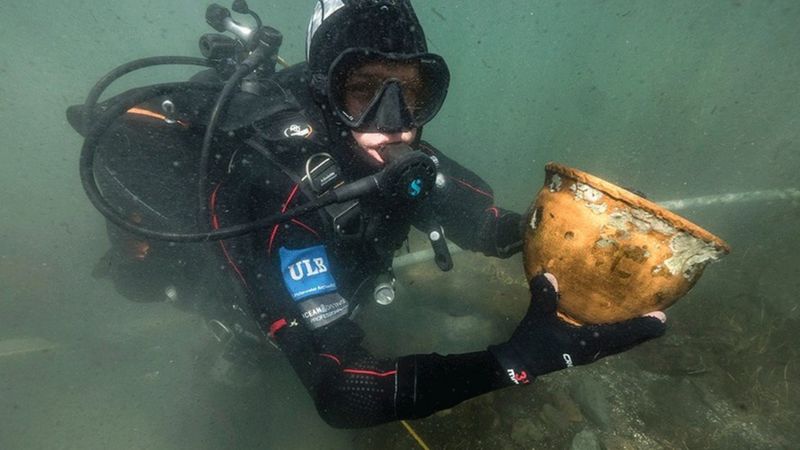The Ancient Ruins On and Beneath the Sacred Lake Titicaca
Marine archaeologists have discovered an ancient ceremonial site identified as exceptional in the Andes, recovering ritual offerings and the remains of slaughtered animals from a reef in the centre of Lake Titicaca.
The extraordinary haul points to a history of highly charged ceremonies in which the elite of the region’s Tiwanaku state boated out to the reef and sacrificed young llamas, seemingly decorated for death, and made offerings of gold and exquisite stone miniatures to a ray-faced deity, as incense billowed from pottery pumas.
The Kingdom of Tiwanaku emerged between the 5th and 12th Centuries A.D. in the Titicaca Lake Basin, near the border of modern Bolivia and Peru, and became one of the strongest and most powerful in the Andes.

Formed by a natural fault that divides the Andes into two mountain ranges, the basin is a unique ecosystem with an “inland sea” set 3,800m above sea level. At the time of the Spanish conquest, the basin was home to an estimated 1 million people.
Marine archaeologists decided to explore the Khoa reef after amateur divers found a number of ancient items at the site. The reef is submerged in more than 5m of water about 10km off the northwestern tip of the Island of the Sun, a central feature of Lake Titicaca.
The researchers excavated a trove of artefacts including a lapis lazuli puma figurine and other miniature stone animals, ceramic puma incense burners and gold ornaments including engraved sheets, a medallion, and an L-shaped piece marked with puma and condor silhouettes.
Perforated gold leaves still attached to fragments of leather may have been used to make ear tassels and another regalia to dress young llamas killed in the ancient ceremonies, the researchers believe.
Taken together, the items reveal how the lavish ceremonies displayed and disposed of the most prestigious materials that money could buy in the ancient Andean empire. Besides the gold and the carved and polished stones were spiny oyster shells from the warm waters off the Ecuadorian coast, nearly 2,000km away. They could only have been obtained through trade.
“What is great about these artefacts is that, beyond their beauty and the quality of manufacture, they were discovered in an undisturbed context,” said Christophe Delaere, a marine archaeologist at the University of Oxford and the Free University of Brussels.
“This is one of the advantages of underwater heritage. Lake Titicaca protects its ancient material culture from time and man. Never before have so many artefacts of this quality been discovered. The history that these objects tell us is exceptional.”
Found alongside the artefacts were llama bones and the remnants of burnt fish, the latter of which is thought to have been eaten during the ceremonies.
Carbon dating of charcoal and bones at the site found that the offerings were made throughout the 8th and 10th centuries AD, according to a report in the Proceedings of the National Academy of Sciences.
The ancient offerings are not the first riches to be recovered from Lake Titicaca, but the exceptional quality and abundance of the items put the reef at the heart of the Tiwanaku people’s beliefs and ritual landscape.
One of the major questions surrounding the Tiwanaku state is how it expanded so effectively across the Titicaca basin in the first millennium. Charles Stanish, an anthropologist on the team from the University of South Florida, said that pilgrimages leading up to elaborate ceremonies were a crucial part of the state structure. Through ritual, religion and “supernatural punishers”, the state encouraged cooperation and deterred freeloaders and other rebels.
“What we’ve discovered in the Titicaca basin are pilgrimages and ritual processions and these are part of the state apparatus. As you participate in them you are reinforcing the power of the state,” Stanish said.
“Combined with what’s been found of other islands in the 1990s, the discovery of these items on the reef shows us there was probably a series of pilgrimages or precessions around the lake and I find that to be extremely exciting.”
More than a dozen Tiwanaku sites have been found on the Island of the Sun. One, near the north-west shore, is a puma-shaped ceremonial complex.
But from Khoa reef, those taking part in a water ceremony would have a panoramic view of the lake and the spectacular surrounding mountains. “It is not surprising that the Tiwanaku elite appropriated this space for costly and highly charged ceremonies,” the authors write.
“Ritual and religion were profoundly important in ancient states. It is not some new age-y thing,” said Stanish. “Ritual and religion structured people’s lives, it structured the economy and the whole of society. This is how these people were able to create spectacular ways to get along and have a very successful society.”


